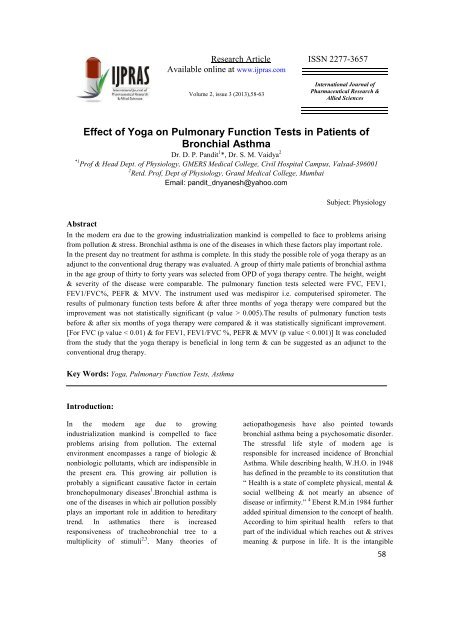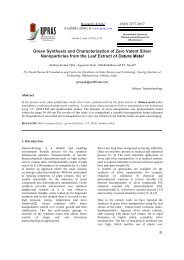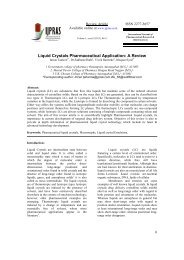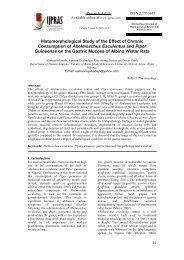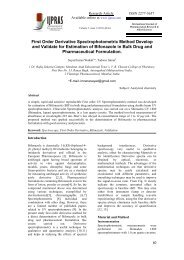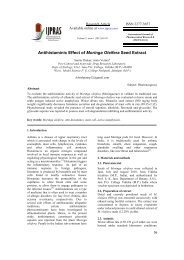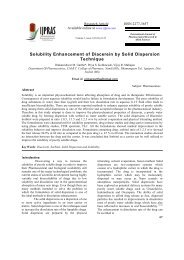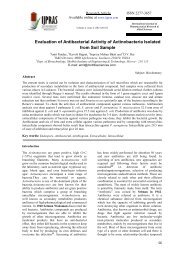Pulmonary Function Tests in Patients of Bronchial Asthma - Yoga ...
Pulmonary Function Tests in Patients of Bronchial Asthma - Yoga ...
Pulmonary Function Tests in Patients of Bronchial Asthma - Yoga ...
Create successful ePaper yourself
Turn your PDF publications into a flip-book with our unique Google optimized e-Paper software.
Available onl<strong>in</strong>e at www.ijpras.com“someth<strong>in</strong>g” that transcends Physiology &Psychology 5 . <strong>Yoga</strong> is one such approach whichwas widely practiced <strong>in</strong> ancient India. <strong>Yoga</strong><strong>in</strong>volves physical, mental, social, spiritual aspect<strong>of</strong> human existence 6 . Today <strong>in</strong> India as well asmany other countries there are many <strong>in</strong>stitutionsus<strong>in</strong>g yoga as part <strong>of</strong> therapy for patients suffer<strong>in</strong>gfrom a variety <strong>of</strong> diseases. Mear popularity <strong>of</strong> asystem however, can not be a measure <strong>of</strong> itsreliability. It was therefore felt the efficacy <strong>of</strong> theyogatherapy needs to be assessed by someobjective tests such as pulmonary function tests.Hence the study was undertaken to evaluate therole <strong>of</strong> yoga therapy <strong>in</strong> the treatment <strong>of</strong> bronchialasthma as an adjunct to the conventional drugtherapy.Materials & methods:A group <strong>of</strong> 30 patients <strong>of</strong> bronchial asthma wasselected from the OPD <strong>of</strong> Kabirbaug mathsamatha, Narayan peth, Pune-30S<strong>in</strong>ce age, sex, height & weight affect thepulmonary function tests follow<strong>in</strong>g criteria wereused for selection <strong>of</strong> subject 7 .The selection criteria:1) The patients were chosen from the age group<strong>of</strong> 30-40 years.2) Only male patients who were hav<strong>in</strong>g history <strong>of</strong>bronchial asthma s<strong>in</strong>ce m<strong>in</strong>imum four tomaximum six years, were selected. They wereon conventional drug therapy for the sameperiod.3) The heights <strong>of</strong> all the patients ranged from160-170 cm.4) The weights <strong>of</strong> all the patients ranged from 55-60 kgThe exclusion criteria:1) The patients who showed only seasonalattacks2) The patients who were hospitalised <strong>in</strong> the last5 years due to severe attacks <strong>of</strong> bronchialasthma which had required ventilator support.3) The patients who were hav<strong>in</strong>g history <strong>of</strong> anyother major illness viz: hypertension, diabetesmellitus, heart disease etc.4) The patients who had history <strong>of</strong> smok<strong>in</strong>g.The follow<strong>in</strong>g pulmonary function tests wereperformed at the time <strong>of</strong> enrolment <strong>in</strong> the yogatherapy class. They were repeated aga<strong>in</strong> after 3months & 6 months <strong>of</strong> yoga therapy.i] Forced vital capacity [FVC]ii]Forced expiratopry volume1 [FEV1]iii] Forced expiratopry volume1/ Forced vitalcapacity% [FEV1/ FVC%]iv] Peak expiratory flow rate [PEFR]v] Maximum voluntary ventilation [MVV]All the above tests were done at the same time <strong>of</strong>the day i.e. between 7 to 8 a.m. to avoid diurnalvariation. The patients were advised to cont<strong>in</strong>uewith their conventional drug therapy. The results<strong>of</strong> pulmonary function tests before & after yogatherapy were compared & statistically analyzed.<strong>Patients</strong> used to perform yogasana for one hour aday. The yogic curriculum <strong>in</strong>cluded prayersfollowed by chant<strong>in</strong>g ‘om’, pranayama,meditation & different asanas i.e. differentphysical postures.The asanas performed <strong>in</strong> the yoga therapy classwere as follows.1] Suptaveerasana2] Suptabaddhakonasana3] Vipareetdandasana4] Merudandasana5] Kapotasana6] Sarvangasana7] Shavasana.Details about the Equipment:The <strong>in</strong>strument used for perform<strong>in</strong>g thepulmonary function tests was a computerisedspirometer ‘medispiror’. [ Recorders & MedicareSystems: 181/5, phase-1, <strong>in</strong>dustrial area,Chandigarh-160002] Specifications:Flow detection: Volume differential methodOverall accuracy: with<strong>in</strong>+ 1%59
Available onl<strong>in</strong>e at www.ijpras.comRange: 0-7 LitresFlow: 0-16 Litres/secPr<strong>in</strong>ter type : thermalA] For Forced Capacity measurement:The subject is asked to sit comfortably <strong>in</strong> an erectposture <strong>in</strong> a chair. He was made to <strong>in</strong>hale asdeeply as possible & expire forcefully <strong>in</strong> themach<strong>in</strong>e, with nose clip applied <strong>in</strong> its place. Thethree read<strong>in</strong>gs are taken at an <strong>in</strong>terval <strong>of</strong> 5 m<strong>in</strong>utes& the best record show<strong>in</strong>g maximum efforts bythe subject is selected. FVC, FEV1, FEV1/FVC%, PEFR are recorded simultaneously.B] For Maximum Ventilatory Volume: Thesubjects were asked to breath <strong>in</strong> & out through themouthpiece as rapidly & as deeply as possible for12 seconds. After the test is complete the read<strong>in</strong>gs<strong>of</strong> MVV is expressed <strong>in</strong> Litres / M<strong>in</strong>ute. All themeasured values are at BTPS (Body Temperature& Pressure Saturated with water vapour).Results & Discussion:Table I: Show<strong>in</strong>g mean & standard deviation <strong>of</strong> observations before & after 3 months & after 6months <strong>of</strong> <strong>Yoga</strong>therapyParameters Before After 3 months After 6 monthsMean S.D. Mean S.D. Mean S.D.FVC (L) 2.51 0.23 2.57 0.19 2.74 0.36FEV1 (L) 1.52 0.15 1.57 0.17 1.80 031FEV1/ FVC % 60.20 2.21 60.85 3.77 63.46 3.98PEFR (L/Sec) 5.59 0.26 5.70 0.35 5.97 0.36MVV (L/M<strong>in</strong>) 85.99 2.79 88.02 6.72 91.03 5.69Table II: Show<strong>in</strong>g results <strong>of</strong> paired‘t’ testBefore & After 3 SignificanceParameters months <strong>of</strong> yoga therapy‘t’ value p valueFVC (L) 1.31 >0.005 Not significantFEV1 (L) 1.56 >0.005 Not significantFEV1/ FVC % 1.23 >0.005 Not significantPEFR (L/Sec) 1.93 >0.005 Not significantMVV (L/M<strong>in</strong>) 1.80 >0.005 Not significantTable III: Show<strong>in</strong>g results <strong>of</strong> paired‘t’ testBefore & After 6 SignificanceParameters months <strong>of</strong> yoga therapy‘t’ value p valueFVC (L) 2.89
Available onl<strong>in</strong>e at www.ijpras.comDiscussion:Our results after 6 months <strong>of</strong> yoga therapy aresimilar to those <strong>of</strong> the work <strong>of</strong> the done byAnilkumar 8 et al, Nagendra & Nagarathna 9 , ja<strong>in</strong>S.C. 10 et al. It may be due to similar techniques<strong>of</strong> yoga therapy, similar number <strong>of</strong> patientsselected & severity <strong>of</strong> the diseases <strong>in</strong> patientsselected. Our results after 6 months <strong>of</strong>yogatherpy are not similar to those <strong>of</strong> KhanamA.A 11 . et al, Tandan M.K 12 . et al, Bhole M.V 13 .Virendras<strong>in</strong>gh 14 et al. It may be due to thedifferent age groups, different asanas used,smaller number <strong>of</strong> sample size & higher severity<strong>of</strong> <strong>of</strong> the diseases <strong>in</strong> their studies as compared toour study. In our study the beneficial effects <strong>of</strong>yoga therapy <strong>in</strong> patients <strong>of</strong> bronchial asthma areprobably through various mechanisms asfollows.In pranayama there is prolonged<strong>in</strong>spiration as well as expiration. This stretchesthe elast<strong>in</strong> & collagen fibres. Hence afterpranayama practice these fibres elongate to agreater extent there by <strong>in</strong>creas<strong>in</strong>g the compliance<strong>of</strong> the lungs 15 . The surface tension <strong>of</strong> the fluidl<strong>in</strong><strong>in</strong>g <strong>of</strong> the <strong>in</strong>side walls <strong>of</strong> the alveoli tends tocollapse the alveoli. The surface tension isgreatly reduced by surfactant 16 . It is claimed thatthe lungs <strong>in</strong>flation near to the total lung capacitywhich occurs dur<strong>in</strong>g pranayama is a majorPhysiological stimulus for release <strong>of</strong> surfactanthence <strong>in</strong>crease <strong>in</strong> lung compliance 16 .Also it is observed that yoga practicesfor long periods cause decrease <strong>in</strong> oxygenconsumption per unit work & blood lactatelevels 17 . It <strong>in</strong>dicates better oxygen delivery &improved oxygen utilization due to improvedcellular respiration. Hence there is decreaseddemand for oxygen. As shown by Nagendra &Nagarathna, yoga therapy acts by reduc<strong>in</strong>g theresponsiveness <strong>of</strong> the tracheo-bronchial tree 18 .As there is decreased responsiveness <strong>of</strong> thetracheo-bronchial tree there is less frequency <strong>of</strong>attacks <strong>in</strong> patients <strong>of</strong> <strong>Bronchial</strong> asthma 11 .Asanas <strong>in</strong>volved <strong>in</strong> yoga therapy aredifferent types <strong>of</strong> postures. Certa<strong>in</strong> postures suchas <strong>in</strong>verted postures (e.g. Sarvangasana) facilitateexhalation. Because <strong>of</strong> weight <strong>of</strong> the abdom<strong>in</strong>alcontents on the diaphgram & / or compression <strong>of</strong>the chest. Backward bend<strong>in</strong>g asanas (e.g.Kapotasana) facilitate <strong>in</strong>halation because <strong>of</strong> thenature <strong>of</strong> the expansion <strong>of</strong> the chest. Certa<strong>in</strong>twist<strong>in</strong>g asanas (e.g. Merudandasana) facilitateunilateral expansion <strong>of</strong> one side <strong>of</strong> the chest &concomittent compression <strong>of</strong> the other side. Alsoasanas with <strong>in</strong>verted postures (e.g.Sarvangasana) help <strong>in</strong> <strong>in</strong>creased expulsion <strong>of</strong> themucus by postural dra<strong>in</strong>age 19 . After regular yogapractices there is improvement <strong>in</strong> skeletal musclestrength <strong>in</strong>clud<strong>in</strong>g <strong>in</strong>spiratory, expiratorymuscles & abdom<strong>in</strong>al muscles. So there is<strong>in</strong>crease <strong>in</strong> the results <strong>of</strong> the pulmonary functiontests 16,20 .Udupa K.N., has studied the excretionpattern <strong>of</strong> the neurohormons <strong>in</strong> the ur<strong>in</strong>e <strong>of</strong> thepatients <strong>of</strong> bronchial asthma <strong>in</strong> the yoga cl<strong>in</strong>ic.Amongst the neurohormons <strong>of</strong> ur<strong>in</strong>ary excretion<strong>of</strong> chol<strong>in</strong>e , adrenal<strong>in</strong>e-noradrenal<strong>in</strong>e & 17hydroxy corticosteroids were studied. Theyroughly <strong>in</strong>dicate the turnover <strong>of</strong> Ach,catecholam<strong>in</strong>es & cortisol respectively. It wasfound that with the cl<strong>in</strong>ical improvement <strong>in</strong> thepatients <strong>of</strong> bronchial asthma there was decreasedchol<strong>in</strong>e content but <strong>in</strong>creased adrenal<strong>in</strong>noradrenal<strong>in</strong>e& 17 hydroxy corticosteroidscontent <strong>of</strong> the ur<strong>in</strong>e. It was concluded from theobservations that yoga tra<strong>in</strong><strong>in</strong>g given to thepatients are Physiological procedures withoutany drug which fully correct the Biochemicaldeficiencies & br<strong>in</strong>g them towards normal levels.In earlier studies it was shown that yogatra<strong>in</strong><strong>in</strong>g helps to establish parasympatheticdom<strong>in</strong>ance <strong>in</strong> people practic<strong>in</strong>g yoga. While thestudy done by Gharote M.L. et al, <strong>in</strong>dicated thatthere was <strong>in</strong>creased tendency <strong>of</strong> the patients <strong>of</strong>bronchial asthma towards sympatheticdom<strong>in</strong>ance after yoga therapy. Accord<strong>in</strong>g tothem it may be due to the different nature <strong>of</strong> theyoga techniques practiced. Also the effects <strong>of</strong>yoga depend on the subjects chosen for the studybecause yoga is said to improve the function<strong>in</strong>g<strong>of</strong> the depressed system either sympathetic orparasympathetic. Thus yoga therapy helps torestore the autonomic balance throughstimulat<strong>in</strong>g effect on <strong>in</strong>ternal organs.It was also observed that there werecorrespond<strong>in</strong>g changes <strong>in</strong> the levels <strong>of</strong>neurohormons <strong>of</strong> sympathetic & parasympatheticsystem. Antistress effect <strong>of</strong> yoga has beenalready demonstrated by many workers, show<strong>in</strong>g<strong>in</strong>creased rate <strong>of</strong> appearance <strong>of</strong> alpha waves <strong>in</strong>EEG, <strong>in</strong>dicat<strong>in</strong>g a relaxed wakeful state <strong>of</strong> body& m<strong>in</strong>d dur<strong>in</strong>g meditation. This po<strong>in</strong>ts to yoga’sstabiliz<strong>in</strong>g effects on the nervous system. The61
Available onl<strong>in</strong>e at www.ijpras.commeditation & Shavasana are clearly associatedwith reduced metabolic rate. Accord<strong>in</strong>g toNagendra & Nagarathna this deep physical &mental relaxation helps <strong>in</strong> decreas<strong>in</strong>g theexcessive efferent vagal activity <strong>in</strong> patients <strong>of</strong><strong>Bronchial</strong> asthma which is recognized as themediator <strong>of</strong> the psychosomatic mechanisms <strong>in</strong>asthma. Also because <strong>of</strong> the regular practice <strong>of</strong>yoga the subjective feel<strong>in</strong>g <strong>of</strong> well be<strong>in</strong>g helped<strong>in</strong> improv<strong>in</strong>g compliance <strong>of</strong> the patients whichmade them to take their medic<strong>in</strong>es regularly.That also helped <strong>in</strong> better control <strong>of</strong> the disease<strong>in</strong> later half <strong>of</strong> the period. The variousmechanisms which might be work<strong>in</strong>g <strong>in</strong> yogatherapy are: stretch<strong>in</strong>g <strong>of</strong> elast<strong>in</strong> & collagenfibres, decreased surface tension, <strong>in</strong>creasedcompliance <strong>of</strong> lungs, decreased oxygenconsumption, decreased responsiveness <strong>of</strong>trachea-bronchial tree, postural advantage,improved skeletal muscle strength, <strong>in</strong>creasedsecretion <strong>of</strong> corticosteroids, psychosomaticadvantages etc. All these effects resulted <strong>in</strong>decreased frequency <strong>of</strong> attacks <strong>of</strong> asthma,thereby decreased compromis<strong>in</strong>g <strong>of</strong> thepulmonary function tests over the period.Conclusion:It was concluded from the present study thatyoga has a beneficial effect on the patients <strong>of</strong>bronchial asthma & hence yoga therapy can besuggested as an adjunct to the conventional drugtherapy for the patients <strong>of</strong> bronchial asthma.<strong>Yoga</strong> therapy may help to reduce the dosages <strong>of</strong>the drugs. This further study needs to beundertaken.Acknoledgement:Kabirbaug Mathsamstha, Narayan Peth, Pune-411030.“Cite this article”D. P. Pandit, S. M. Vaidya “Effect <strong>of</strong> <strong>Yoga</strong>on <strong>Pulmonary</strong> <strong>Function</strong> <strong>Tests</strong> <strong>in</strong> <strong>Patients</strong> <strong>of</strong><strong>Bronchial</strong> <strong>Asthma</strong>” Int. J. <strong>of</strong> Pharm. Res. &All. Sci.2013; Volume 2, Issue 3,58-63References:1] Slonim N.B. & Hamilton H.RespiratoryPhysiology: 5 th ed, The CV Mosby company,Missouri; PN 2312] Harrisons Pr<strong>in</strong>ciples <strong>of</strong> Internal Medic<strong>in</strong>e:14 th ed, Vol 2: Mc Graw Hill, Inc. HealthPr<strong>of</strong>ession Division3] Szentivany A.: The beta adrenergic theory <strong>of</strong>the autonomic abnormality <strong>in</strong> bronchial asthma,J. <strong>Asthma</strong>,1986;23:123-1374] Park K.: Textbook <strong>of</strong> Preventive & socialMedic<strong>in</strong>e: 15 th ed, M/s Banarasidas Bhanot:125] Eberst R.N.: Jr. School <strong>of</strong> Health, (1984);54(3): 99-1096] Kuvalayanand swami: <strong>Yoga</strong> therapy, 1 st ed,Central health education bureau, Directorategeneral <strong>of</strong> health services, M<strong>in</strong>istry <strong>of</strong> health,Govt <strong>of</strong> India,New Delhi7] Cotes J. E.: ‘Lung <strong>Function</strong>: Assessment &Application’: 5 th ed, 1979; Blackwell ScientificPublication8] Anilkumar P.K., Gnankumari K. et.al:Immediate effects <strong>of</strong> pranayama <strong>in</strong> airwayobstruction: Lung India, 1985: III, No.2: 77-819] Nagendra H.R., Nagarathna R.: <strong>Yoga</strong> forbronchial asthma- A controlled study: BritishMedical journal, 19 th Oct 1985: vol291: [1077-1079]10] Ja<strong>in</strong> S.C., Talukdar, B., Evaluation <strong>of</strong>yogatherapy programme for patients <strong>of</strong> bronchialasthma, S<strong>in</strong>gapore medical journal, 1993, 34[4];306-30811] Khanam Ayesha Akthar, Sachdeva Usha etal, study <strong>of</strong> pulmonary Autonomic functions <strong>of</strong>asthma patients after yoga tra<strong>in</strong><strong>in</strong>g: IndianJournal <strong>of</strong> Physiology & Pharmacology, 1996:40(4) : 318-32412] Tandon M. K., Adjunct treatment with yogachronic severe airway obstruction, Thorax, 1978;33:514-51713] Bhole M. V., Effects <strong>of</strong> yogic treatment onvarious lung functions <strong>of</strong> asthma patients: Apilot study; yogamimansa, Jan, !982: volXX,No.4:43-5014] Virendrs<strong>in</strong>gh, Antoni Wisniewski,et al,Effect <strong>of</strong> yoga breath<strong>in</strong>g exercises on airway62
Available onl<strong>in</strong>e at www.ijpras.comreactivity <strong>in</strong> subjects with asthma;Lancet,June9,1990; Vol.335: 1381-8315] Joshi K.S.; <strong>Yoga</strong> & pranayama; Visionbooks Pvt. Ltd., Bombay16] Joshi L.N., Joshi V.D., et al, Effect <strong>of</strong> shortterm pranayama practice on breath<strong>in</strong>g rate &ventilator functions <strong>of</strong> lung; Indian journal <strong>of</strong>Physiology & Pharmacolgy; April 1992, 36(2):105-10817] Raju P.S., S. Madhavi, et al, Comparison <strong>of</strong>effects <strong>of</strong> yoga & physical exercise <strong>in</strong>athletes;IJMR; Aug 94(100): 81-8718] Nagendra H.R., Nagaratna R.: <strong>Yoga</strong> forbronchial asthma- A controlled study: BritishMedical Journal, 19 th Oct1985; vol291:1077-107919] Swami Shankar Devanand Saraswati(MBBS); <strong>Asthma</strong> & Diabetes; ed. 4 th ; Biharschool <strong>of</strong> yoga; Munger; Bihar;India20] Madan Mohan, Thombare D. P., et al; Effect<strong>of</strong> yoga tra<strong>in</strong><strong>in</strong>g on reaction time, respiratoryendurance & muscle strength: Indian journal <strong>of</strong>Physiology & Pharmacology;1992;36(4): 229-23321] Udupa K. N.: Stress & its management byyoga: 2 nd revised & enlarged ed,1985: MotilalBanarasidas Bunglow rd, Delhi,110007.22] Wenger M.A. & Bagachi,B.K.: A report onPsychophysiological <strong>in</strong>vestigations <strong>in</strong> India: Pvtcirculation, 1960.23] Gharote M.L., Bhole M.V, et al, effect <strong>of</strong>yoga treatment on autonomic balance <strong>in</strong>asthmatics: A pilot study: <strong>Yoga</strong>mimansa, April-July 83: XXII, No.1&2;73-79.24] Telles S., Nagarathna, et al,: physiologicalchanges <strong>in</strong> sports teachers follow<strong>in</strong>g 3 months<strong>of</strong> tra<strong>in</strong><strong>in</strong>g <strong>in</strong> yoga: Indian J Medicalsciences:1993:47[10]: 235-23825] Bagachi. B.K. & Wenger M.A.: ElectroPhysiological correlates <strong>of</strong> some yogic practices.First International congress <strong>of</strong> NeurologicalSciences, Brussels, 1957: vol.III26] Wallace R.K.(1970): Physiological Effects <strong>of</strong>Transcendental Meditation: Science,1970:167:1751-175427] Nagendra & Nagarathna R.: <strong>Yoga</strong> forbronchial asthma- A controlled study: BMJ, 19 thOct. 1985,: Vol. 291: [1077-1079]63


